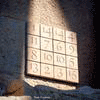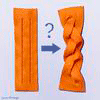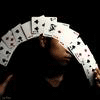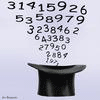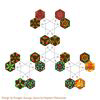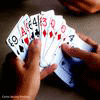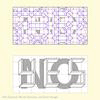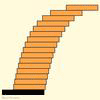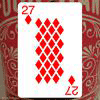Mathematics Awareness Month 2014: Mathematics, Magic, and Mystery
Navigate the Calendar
Geometrical Vanishes
A geometrical vanish (or geometric vanish) is a puzzle comprising several pieces whose area seems to change according to how the pieces are arranged. Common sense tells us this is impossible! But is it? Consider this model, presented by Argentine magician Norberto Jansenson:
Computer scientist, magician, and puzzle collector Christopher Morgan explains:
Download the template for the Martin Gardner dollar bill geometric vanish.
Taking it Further
Perhaps the most famous geometrical vanish was invented by the great Sam Loyd, an American puzzle creator whose Get Off the Earth puzzle reportedly sold over 10 million copies during his lifetime. A selection of vanishing puzzles by Loyd and others have been cataloged by Mariano Tomatis.
Many famous geometrical vanishes were invented by the great Sam Loyd, an American puzzle creator whose Get Off the Earth puzzle reportedly sold over 10 million copies during his lifetime. A selection of vanishing puzzles by Loyd and others have been cataloged by Mariano Tomatis. In this video MoMath Co-Executive Director, Cindy Lawrence demonstrates the Monkey Around puzzle at the Museum of Mathematics in New York City. Martin Gardner selected this puzzle himself for inclusion in the museum’s exhibits. It is a splendid example of a puzzle in the same genre as Loyd’s Get Off the Earth. You can explore the geometry of this different type of geometric vanish with this activity.
The puzzle based on rearranging the pieces of an 8×8 square to form a 5×13 rectangle is another classic, having first appeared in print in 1868, according to W.W. Rouse Ball in Mathematical Recreations and Essays. That the numbers 5, 8, and 13 are all Fibonacci numbers is no accident! Note also the dimensions of the pieces into which the original square is cut—3, 5, and 8—are also Fibonacci numbers! So Here’s a challenge: Can you build a similar puzzle based on a square and a rectangle of different dimensions than these? (You will find a hint in the next section.)
And once you understand that, can you fathom what’s happening here? It has been discussed extensively on Reddit. Below is the gif that sparked the discussion, and a hint of what is going on can be found here.
The Underlying Mathematics
The first order of business is to note that chapters seven and eight of Martin Gardner’s Mathematics, Magic and Mystery (Dover, 1956) are entirely devoted to geometric vanishing puzzles, including many of those featured here.
It is no accident that the Fibonacci numbers are at work behind the scenes in many such puzzles. Recall that the Fibonacci sequence begins like this:
The sum of any two consecutive numbers in the sequence produces the next number in the sequence. It is well known that the square of any Fibonacci number (except the first) differs from the product of the two numbers on either side of it by precisely one. For example, 8×8 = 64, while 5×13 = 65. Moreover, a careful inspection of the sizes of the four pieces that form the 8×8 square in the vanishing puzzle discussed earlier are also based on Fibonacci numbers. That pattern can be replicated to fabricate similar geometric vanishes. The details can be found in Gardner’s book, referenced above.



